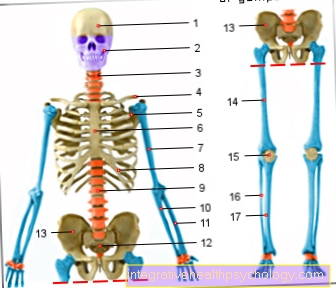Trigeminal palsy
definition
The trigeminal nerve is one of the most important nerves in the human body. It is counted among the so-called cranial nerves. These are characterized by the fact that they all arise directly from the brain stem. The main task of the trigeminal nerve is, in addition to the nervous supply (innervation) of the masticatory muscles, above all, the perception of the sensations in the facial area (sensitivity). These functions can fail due to paralysis of the nerve, as can be the case with trigeminal palsy. The causes for such a malfunction can be very different.

causes
There are several causes that can lead to trigeminal nerve paralysis. In addition to inflammation, masses or increased pressure in the brain, these include damage to the nerve as a result of an accident. A distinction has to be made between a central and a peripheral lesion. Depending on the location of the injury, different failures are the result.
Since the trigeminal nerve is counted among the cranial nerves, it has its origin in the brain stem. He is based on so-called cranial nerve nuclei, which are responsible for the various functions of the nerve, such as sensitivity or motor skills. If one of these nuclei fails due to an injury or due to displacement, for example by a tumor, specific failures can occur. This can lead to a loss of sensitivity in the face without the movement of the masticatory muscles being restricted.
However, the peripheral injury to the trigeminal nerve and its branches is far more common. It is important to know that the nerve divides into three large main branches. These nerve branches can be injured more quickly in an accident and then cause a disturbance of the sensitivity in only a certain area of the face. Another cause that can lead to trigeminal palsy is trigeminal neuroma, a benign tumor of the nerve sheath.
You might also be interested in: Neurinoma
diagnosis
Since trigeminal palsy causes very specific deficits in sensitivity and motor skills in the face, a diagnosis can be made relatively easily. Often patients first report loss of sensitivity in the face, which is the reason for a visit to the doctor. First of all, it is important to distinguish whether there is a central injury to the nerve in the area of the brain stem, or whether only individual nerve branches show a loss of function.
To do this, the doctor checks the sensitivity of the entire face and the function of the masticatory muscles. If only one branch of the nerve is affected, there will only be a loss of sensitivity in the forehead or lower jaw, for example. If, on the other hand, there is a central injury to the nerve or its nuclei, the pattern of failures is different from that of a peripheral injury. The loss of sensitivity then follows the so-called Sölder lines.
An MRI, magnetic resonance imaging, should also usually be performed in order to rule out further injuries or causes. It is also important to distinguish it from trigeminal neuralgia, which can be made on the basis of the symptoms.
Read more on the topic: Procedure of an MRI
Concomitant symptoms
The trigeminal nerve is the most important sensitive nerve in the facial area. If there is a paresis or paralysis of the nerve, this has great consequences for the patient concerned. Depending on the location of the constriction or the injury to the nerve, various failures occur.
If there is a central lesion, i.e. an injury to the nucleus of origin of the nerve, complete sensitivity and pain and temperature perception may be lost, depending on the extent. In addition, the mobility of the masticatory muscles can be restricted.
If the paresis is only present on one side, the cheek muscles can hang down a little compared to the healthy side. If the upper branch, the opthalmic nerve, is injured, the eyelid-closing reflex may fail.
Furthermore, it is not uncommon for trigeminal neuralgia, i.e. nerve pain, to develop after an injury to the trigeminal nerve or its branches. This is extremely painful and in some cases can only be treated well with surgery.
You might also be interested in this topic: Numbness in the ear - what's behind it?
Treatment / therapy
The therapy for trigeminal palsy depends on the underlying cause of the nerve paralysis.
If there is inflammation of the nerve or the nerve sheath, one can try to get this under control with pain relievers and anti-inflammatory drugs, which is often successful. Some patients also report rapid healing after acupuncture.
If the trigeminal nerve or its branches are injured, in some cases spontaneous regeneration can occur after a while, i.e. self-healing of the nerve. If this is not the case, the nerve can also be sewn back together with an operation, which often results in only a small or no loss of function.
If there are other causes such as masses or a trigeminal neuroma, these may have to be surgically removed.
Duration
The duration of a trigeminal palsy depends largely on the underlying cause.
If the inflammation is treated adequately, healing can take place after just a few weeks. If there is an injury to the nerve, it can take months for the nerve to heal completely. In such cases, sometimes only surgery can bring real improvement.
If the trigeminal nerve is constricted by a mass or a tumor of the nerve sheath, a neurinoma, the symptoms can usually last until this constriction is treated surgically. In some cases, however, the trigeminal nerve is so badly damaged that symptoms persist even after attempted therapy.
forecast
In general, trigeminal palsy usually has a good prognosis. If the nerve is constricted, it can be surgically removed in most cases and the nerve regains full functionality.
If the trigeminal nerve or its branches are injured, for example as a result of an accident, the prognosis depends very much on the degree of damage. If the nerve is only squeezed or only slightly injured, healing usually takes place within the next few months and there are no or only very few losses in sensitivity or motor skills. However, if the nerve is completely severed, the healing process can take significantly longer. Surgical procedures can be used to attempt to sew the nerve endings together, which generally gives very good results. Only in rare cases does the paresis of the trigeminal nerve persist.
Differences from trigeminal neuralgia
There are great differences in terms of cause and symptoms between paresis of the trigeminal nerve, i.e. paralysis, and trigeminal neuralgia, i.e. nerve pain.
A paresis of the nerve is usually associated with a loss of function in the facial area. Sensitivity disorders can occur and the movement of the masticatory muscles can be severely or completely restricted. The exact symptoms depend on the underlying cause and its location.
With trigeminal neuralgia, the main symptom that patients suffer from is severe nerve pain, which is considered to be one of the most severe pains a person can have. They are often stinging and appear suddenly. An entrapment or inflammation of the nerve may initially lead to trigeminal neuralgia, which, if left untreated, can lead to trigeminal palsy.
In both cases, an attempt is first made to treat the cause of the disease with medication. If this does not improve, good surgical methods are available that have a good to very good cure rate.
Read more about this: Trigeminal neuralgia





























